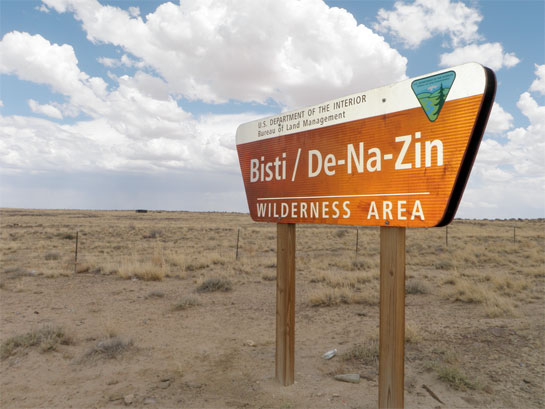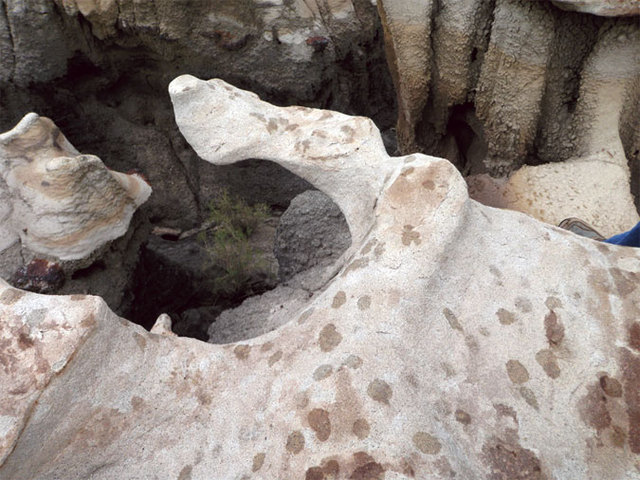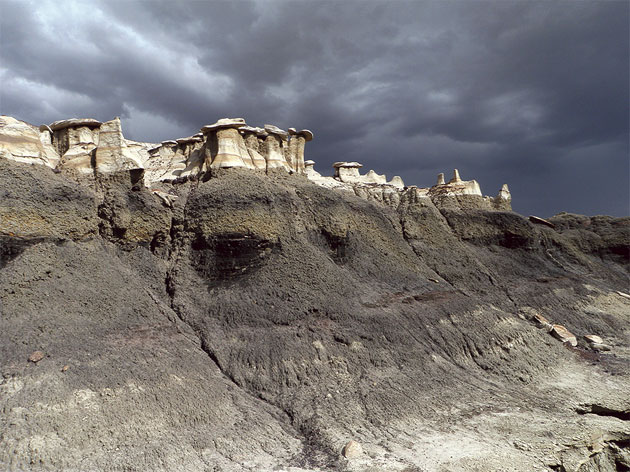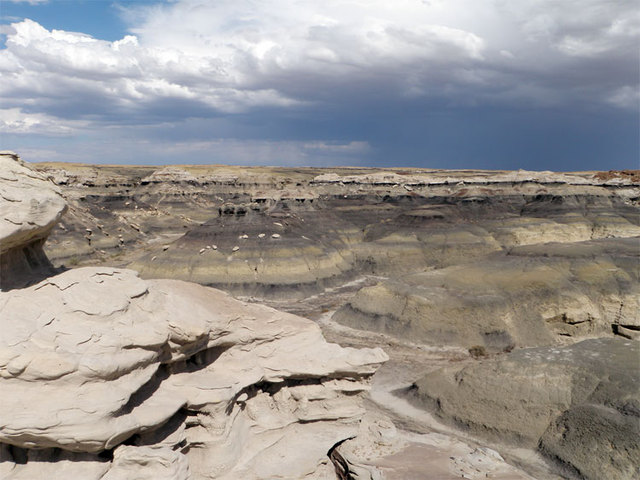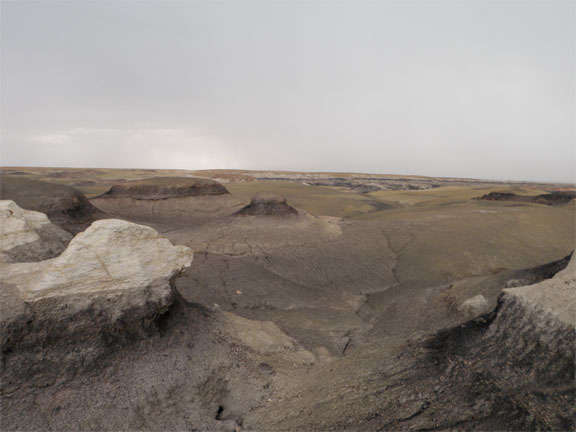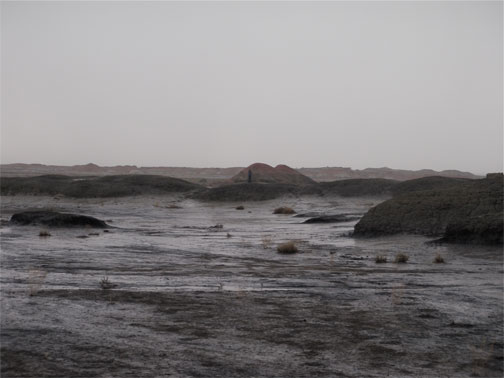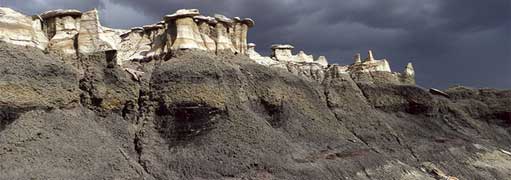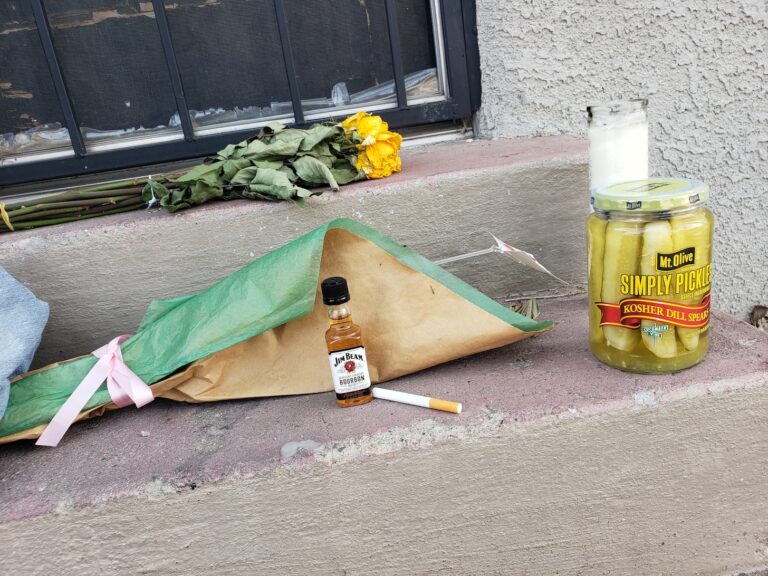The skies did not darken all at once. It was instead a gradual, creeping gloom that, like a cat stalking a lizard, went more or less unnoticed. The plan was simple: Visit the Bisti Badlands with my father. Bisti is about halfway between Thoreau and Farmington in the Four Corners area, a bit off of Highway 371. It’s 40,000 acres of amazing desert. About 70 million years ago the area was lush swampland—dinosaur stomping grounds, in fact. Over millions of years the sun, wind—and, far more rarely, rain—worked in tandem like master carvers to create bizarre landforms that look like something Dr. Seuss would dream up on an acid trip. Bisti is littered with hoodoos—tall, thin earthen columns formed when all sides of a rock are eroded, but the top is protected from rain and wind by a cap of harder stone. The badlands are home to petrified wood, dinosaur bones and smooth mounds of stone that look like soft-serve ice cream dropped onto the ground. If there are any truly magical places in the Land of Enchantment, the Bisti is certainly among them. It’s one of the most photogenic yet least visited areas of New Mexico, partly because of its remoteness. I’ve been a student of wilderness disasters for many years, fascinated by people who go off the beaten path and end up dead (or nearly dead) in myriad interesting ways: Frank Lenz, who disappeared while bicycling around the world in 1894. Ernest Shackleton’s 1914 expedition to Antarctica, and his team’s miraculous rescue after the ship was crushed in ice. The fateful May 1996 Mount Everest expedition that killed eight climbers. Stuff like that. In the wilderness, disasters rarely happen suddenly. Unless you fall victim to an avalanche or bear attack, or stumble off a cliff, you’re pretty much fine. It’s not one giant leap of risk or stupidity that puts adventurers in the morgue; instead most deaths are caused by little details. A series of seemingly minor mistakes, poor choices or plain bad luck that, in the right combination of the wrong circumstances, cascade into disaster and turn an adventure into a nightmare.Sometimes it’s little things. Just last month, three young California hikers in Yosemite National Park ignored danger signs and crossed a barricade to pose for a photo in the middle of a river. It’s something that thousands of people do every day without incident: A few steps over the fence for a better picture won’t hurt. Most of the time it’s not a problem. This time all three were swept over a 317-foot waterfall and killed. All this ran through my mind as I stood in the rain, wondering where I was and how I was going to get us home. Before we went in, I brought plenty of water in a CamelBak hiking pack. I figured it hadn’t rained in months. I turned off my cell phone and left it in the car—I wasn’t getting a signal anyway. My father, a former Bureau of Land Management worker, had spent time in the region in the 1980s (Bisti is federal BLM land). We hiked a few miles in and wandered from canyon to canyon, drawn by strange forms. Each was more fantastic than the last and called us deeper into the badlands. After another hour we stopped in the slim shade of a cliff for a few minutes to rest, admiring an eagle-shaped rock that stood silent watch. The occasional wind gust through the canyons created a low howl, breaking the silence. Most dirt had long since blown away, and the area was as bare and stark as the surface of the moon.I took off my backpack and bulky SLR camera bag so I could more easily explore ahead. As I heaved myself up a waist-high boulder, I noticed that the sole on my right hiking boot was coming off. I thought little of it and made a mental note to fix it when I got home. We climbed atop the canyon and explored further. While one of us spent a few minutes trying to perfectly frame and photograph an interesting rock, the other would scramble ahead in one direction or another, eager to see what lay over the next hill, and the next. We were like kids on our first trip to Disneyland, wanting to see everything, and right now. I didn’t notice it at the time—I was too busy soaking in the natural beauty—but an ominous gray menace loomed in the sky. It was only a few raindrops at first, a welcome relief from the heat. Then more and more. We were at the top of one of the hills when both the rain and the gravity of the situation hit us. Suddenly I saw the forest for the trees, the bigger picture of our situation and the minor details that would determine how (or whether) we’d get out of this. Playtime was over. We needed to leave. Now. I ran through the basics: We had plenty of water and a few energy bars. We did not have a flashlight, and the sky was getting dark. I’d forgotten to bring a watch. Even though I could estimate pretty accurately when the sun was going to set from its position in the sky, I could have used the watch to judge distance by how long I’d been walking. I was that idiot. This was not a passing cloud. This was a goddamned mini-monsoon. We were only going to get wetter and colder until sunrise tomorrow. The rain was turning the clay slick as snot, making walking slow and treacherous. I had dressed and prepared for hot, dry desert, not cold, wet muck. Sunset was only an hour or two away. It took us about two hours to hike here in dry, clear weather. It could easily take us twice as long to get back, and the storm clouds, in cruel collaboration, hastened the night. We were alone, having seen exactly one parked vehicle on the way in, and its owners were likely long gone. Lightning struck every few minutes.We scrambled down the slippery hills looking for a route that wasn’t too steep. As we reached the bottom, I felt some water in my boot. I looked down to see that the sole on my left boot was coming apart as well. I now had two boots whose mud-filled flaps scooped up more muck with every step. I cursed the rain—something I, as a desert-raised boy, never do. Then I remembered something. Where did I leave my SLR camera, shirt and pack? I turned around, looking through mud- and raindrop-speckled glasses. I thought the canyon was to the left, but my father thought it was to the right. Time was running out. I decided I had about 15 minutes to find it. There was no use in both of us walking any more than necessary, so I had my father stand atop one of the highest mounds within sight, so I’d be able to find him again. I took a photo of him with a pocket digital camera standing on the mound as I left, in case I didn’t recognize it on my way back. As rain pelted down, I slipped and slid trying to find landmarks I recognized. A few hundred yards ahead on my right was the eagle head silhouette high above. We’d come this way. After about 10 minutes down false canyons, I spied my camera bag and backpack. I grabbed them and headed back to find my father. We started in the general direction of where we came, but we soon realized that the landmarks we’d carefully studied were gone. Everything seemed different: The light was different. The shadows were different. Hills literally changed color. The remarkably red and radiant mini-mountains we couldn’t miss on the way in were dulled into generic earthen gray lumps. The playful, fantastic forms that had beckoned to us were cold and mute. Our visibility was cut short by the driving rain. We trudged forward with a combination of intuition, hope and faith that our sense of direction had not failed us. We kept going and going, and finally arrived at the car just ahead of the enveloping darkness. We were hungry, soaked and exhausted.The truth is, I will never really know how close we came to disaster. I’ve spent time in many hostile places, from the Amazon to the Sahara, and I was getting nervous. My father is in pretty good shape, but he’s nearly 70 and has diabetes. I’m about half that age, but with boots dissolving, daylight waning and a few easy wrong turns, I could have ended up cold, wet and nearly barefoot, scrambling over sharp rocks, cacti and God knows what else, in the dark. My ace in the hole was that I knew that the entire area was surrounded by a barbed wire fence. If I could keep my bearings and avoid walking in circles (it happens more than you’d expect), I could go in one direction until I found the fence, then follow it to the entrance. That being said, we’re talking about nearly 40,000 acres. That could take hours, and even longer to drive to Farmington and find help early in the morning (remember, there’s no cell phone reception). Search-and-rescue in wet, rainy, dark conditions in such rugged and unusual terrain could take hours or even days if the weather kept up.After every hike or trip, I spend a few minutes making a list of things I should have done or brought, so I can learn from my mistakes. I should have been prepared for rainy weather. I should have brought a watch and flashlight. I should have double-checked the condition of my boots. I should have checked the weather. I should not have left my pack so far behind—or at least paid better attention to where it was. As they say, the devil is in the details. Luckily the details that went wrong didn’t outweigh the details that went right—this time.
The opinions expressed are solely those of the author.Benjamin Radford has investigated unexplained phenomena for more than a decade. He is a columnist for LiveScience.com and Discovery News, and deputy editor of Skeptical Inquirer magazine. He is author of six books, including Scientific Paranormal Investigation and Tracking the Chupacabra . Both are available at better Albuquerque bookstores.
